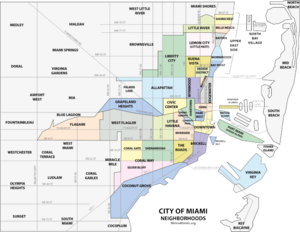
Back Downtown Miami German Downtown Miami Spanish Downtown Miami French Miðborg Miami Icelandic Downtown Miami Italian Downtown Miami Dutch Downtown Miami Portuguese Большой центр Майами Russian Downtown Miami SCO
Downtown Miami | |
|---|---|
 Downtown Miami skyline in 2019 | |
| Nicknames: Downtown, Central Business District | |
 Downtown neighborhoods within the City of Miami | |
| Coordinates: 25°46′26″N 80°11′24″W / 25.774°N 80.190°W | |
| Country | United States |
| State | Florida |
| County | Miami-Dade County |
| City | Miami |
| Settled | 1830s |
| Incorporated into the City of Miami | 1896 |
| Subdistricts of Downtown | |
| Government | |
| • City of Miami Commissioner | Ken Russell (D) |
| • Miami-Dade Commissioners | Vacant |
| • House of Representatives | Luis R. Garcia, Jr. (D) and Cynthia A. Stafford (D) |
| • State Senate | Gwen Margolis (D), Dwight Bullard (D), and Miguel Díaz de la Portilla (R) |
| • U.S. House | Maria Elvira Salazar (R) |
| Area | |
• All Downtown neighborhoods | 3.80 sq mi (9.84 km2) |
| Population (2010)[2] | |
• All Downtown neighborhoods | 66,769 |
| • Density | 17,570/sq mi (6,780/km2) |
| • CBD population only[3] | 13,856 |
| • Daytime population[3] | 250,757 |
| Demonym | Downtowner |
| Time zone | UTC-05 (EST) |
| ZIP Code | 33128, 33129, 33130, 33131, 33132, 33136 |
| Area code(s) | 305, 786 |
| Website | www |
Downtown Miami is the urban city center of Miami, Florida, United States. The city's greater downtown region consists of the Central Business District, Brickell, the Historic District, Government Center, the Arts & Entertainment District, and Park West. It is divided by the Miami River and is bordered by Midtown Miami's Edgewater, and Wynwood sections to its north, Biscayne Bay to its east, the Health District and Overtown to its west, and Coconut Grove to its south.
Downtown Miami is the core of the Miami metropolitan area, the nation's ninth-largest and world's 34th-largest metropolitan area with a population of 6.158 million people.
Within Downtown Miami, Brickell Avenue and Biscayne Boulevard are the main north–south roads, and Flagler Street is the main east–west road. The Downtown Miami perimeters are defined by the Miami Downtown Development Authority as the 3.8-square-mile (9.8 km2) area east of Interstate 95 between Rickenbacker Causeway to the south and the Julia Tuttle Causeway, which connects Miami and Miami Beach, to the north.
The area is a cultural, financial, and commercial center of the Miami metropolitan area, tracing its present-day history back to the 19th century. In recent years, Downtown Miami has the third greatest concentration of high-rises in the United States and is home to many major museums, parks, education centers, banks, company headquarters, courthouses, government offices, theaters, shops and many of the oldest buildings in the city.
- ^ "2016; Greater Downtown Miami Demographics" (PDF). miamidda.com. Applied Research and Analytics. Retrieved March 12, 2020.
- ^ "2016; Greater Downtown Miami Demographics" (PDF). miamidda.com. Applied Research and Analytics. Retrieved March 12, 2020.
- ^ a b "Archived copy" (PDF). Archived from the original (PDF) on October 24, 2018. Retrieved October 24, 2018.
{{cite web}}: CS1 maint: archived copy as title (link)